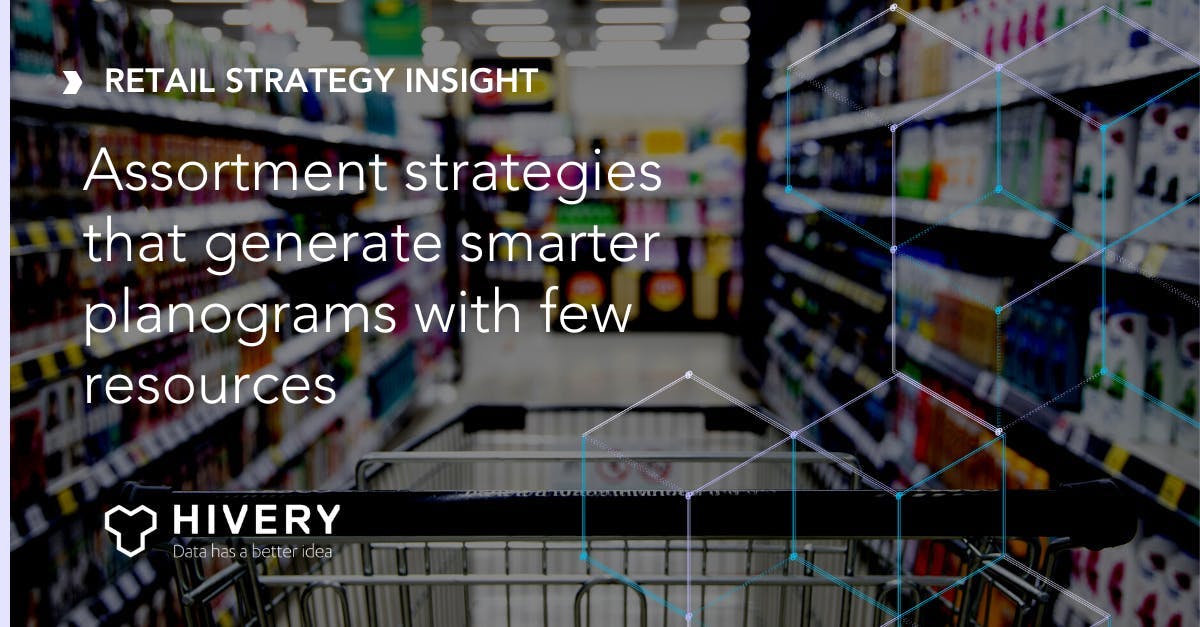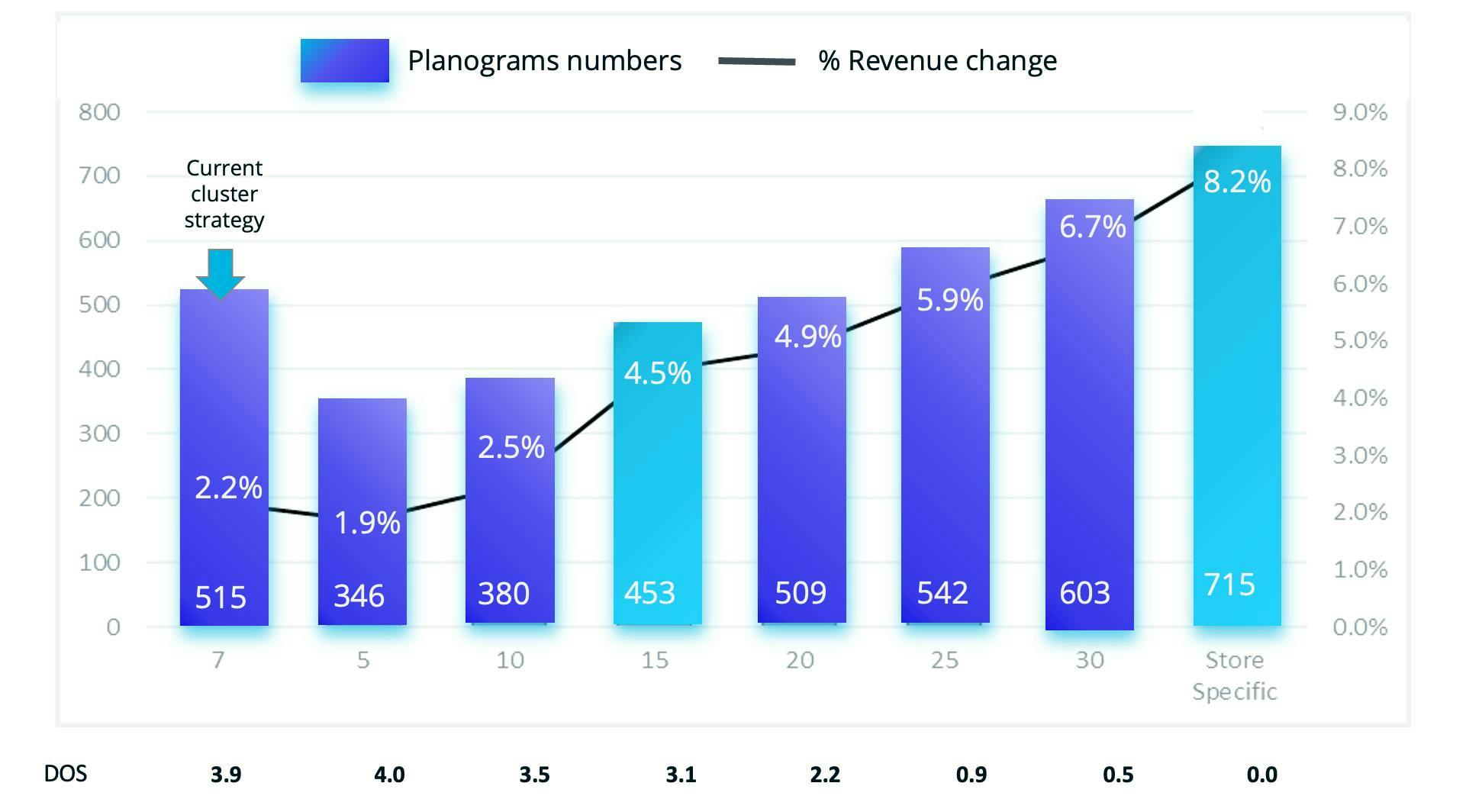
Assortment strategies that generate smarter store clusters & planograms
Grocery stores and retail chains now have the power to leverage AI to make assortment planning more dynamic and responsive and automate planogram creation. Here’s how.
As the retail supermarket industry becomes increasingly complex, operational leaders such as Vice Presidents of Category Management, Merchandising & Marketing in Consumer Goods, and Retailers face tough competition and limited resources; around 90 percent of organizations fail to execute their assortment strategies effectively. Therefore, assortment execution speed and precision at the shelf have become the number one differentiator.
Successful execution is an iterative and rigorous process, but it needs to start with the right strategy. A differentiated strategy is derived from a different perspective. New technologies can provide this different perspective.
This blog will explore how AI can deliver operational efficiency and collaborative power decision-making. But before we go on, we have an example of a client project to share with you. National CPG Health & Beauty Client came to HIVERY looking to understand incremental revenue opportunities if they re-optimize their current clusters.
In the chart below, we were able to use HIVERY Curate to re-optimize their current clusters; our client identified new cluster strategies that provide higher revenue with fewer planograms to draw. By conducting store-level analysis and re-optimization, we developed new cluster strategies. We found that we can increase revenue by 4.5% with a minimal increase in the number of planograms required while also improving DOS performance by 20%. We also showed that if they opted for a store-specific approach, it yielded the highest value with an 8.2% revenue change.
We optimized their existing clusters by leveraging store-level data. This analysis took minutes to run and deliver new precision insight. This analysis did not take months, nor did it rely on many people with special skills in business intelligence (BI), analytics BI or the data science team to generate.
The key point here was that our client could double revenue and reduce planogram drawing while keeping DOS stable for just eight more clusters.
Keep reading for more insight like this.

The Industry Challenge and Opportunity
What got you here today won't get you where you need to be in the future.
One of the biggest challenges in the retail industry is staying ahead of the competition. With so many products on the shelves and new ones being released, it can be difficult to keep up with the latest trends and ensure your store is stocked with the items customers want.
Some of the biggest challenges in the retail industry today are:
- Omnichannel - customer expectations are changing, and there's a need to digitize, which creates a unique challenge
- Rapidly changing consumer behavior
- Market shocks and rising costs
- Data monetization - the role of data in making decisions and the external value it creates
What does this mean, and how does it create opportunities? The future winners will be the ones that can make the transition as efficiently and effectively as possible from a model based on control and standardization model that balances central governance with agility at the edge.
Transforming Space Planning with AI
With the evolution of technology, we're getting access to better and better tools. Leveraging AI involves a partnership between the AI and your experts. These tools are not meant to take over for the human component but instead help augment what the experts do.
The experts provide empathy, intuition, and common sense. The AI provides logic, efficiency and speed, unlimited capacity, and accurate predictions.
AI is the future of retail space planning and, indeed, retail space management, and it can deliver dynamic, strategically aware merchandise plans that are:
- Locally relevant
- Effectively merchandised
- Operationally efficient
- Transparent and collaborative
Locally Relevant Community Stores
Let me start by saying that local matters, and there is value in going local.
With the evolution of retail approaches, we can mitigate operational and capacity constraints. Creating locally relevant community stores is much easier with AI tools.
There are a couple of things that you need to consider with creating locally relevant shelf execution—first, the cluster approach. Clustering tends to be informed by aggravated insights and is often built on geographic assumptions or historical norms.
Second, you need to consider resource capacity. Stores tend to focus on an all-or-nothing approach. However, more success can be achieved if you take advantage of opportunities found in subsets.
The current approach for many community stores is to take decisions and actions at aggregate levels. However, the optimal approach would be to take decisions and actions at the store level.
Effective Merchandising at Scale
Creating locally relevant community stores is the dream, but you need the right merchandising solution to do so effectively. You have to take the information you get, turn it into planograms, and be space aware.
A growing level of complexity hinders decision-making and execution. Because of that, you need to be aware of the following:
- Space constraints
- Sales performance
- Assortment constraints
- Demand transfer
To effectively merchandise, you need to be "strategy aware." Using AI doesn't just mean that you feed data to the AI, and the AI tells you what to do. It's an iterative process because, as a business, you want to achieve things that the data doesn't know.
Instead, AI acts as your co-pilot in decision-making. It helps you find the answers to fundamental strategic questions. It creates auto-generated and space-aware planograms and helps you run different scenarios that can factor into your strategy.
Delivering Operational Efficiency
How do you create efficiency? Often it gets treated as an episodic process. You start with performance goals, market and consumer insights, operational metrics, and strategic objectives.
However, you then have to take that and get to financial forecasts, execution-ready assortments, and store planograms. For most, this is a four to six-month process with 150 steps and many people involved.
However, if you transform your thinking, you can use automation to accelerate the process. Stores need to shift from an imprecise episodic process to a dynamic approach to unlock store/item-level precision.
Powering Collaborative Decision Making
What does it actually mean to be iterative and collaborative? It's important that you recognize that merchandising planning is collaborative, dynamic, and iterative, and the tools you use also need to be.
With AI as your co-pilot, you still need to be aware of the strategy and able to iterate and set merchandise-aware strategic objectives rapidly.
You also need the ability to optimize assortment aligned to your strategy, local customer demand, and space constraints. You can leverage automation to operationalize effectively strategizes across your distribution network.
AI can help you quickly and easily compare different strategies through simulation before executing them. You can ask strategic questions and run different simulations, such as:
- Cluster optimization simulation – what would be the incremental benefit of optimizing my existing clusters? What if I go from our current 6 clusters to 8? AI can help expand revenue opportunity by optimizing your existing clustering approach by understanding the impact on your revenue and volume if we draw 250 planograms instead of 200.
- Slim shelf expansion simulation – If you are investing in different physical shelving in stores, such as a slim shelf, would assortments work better? What stores should we extend more of these new shelves?
- Pack size distribution changes simulation - What if we move from large pack sizes to single serves? Where would the volume go?
Transform Your Store with AI for Assortment Planning and More
AI has the potential to create massive opportunities for community stores. However, you need the right tools to help with assortment planning, space planning, and optimization.
Are you ready to partner with AI that can act as your co-pilot? HIVERY is a pioneer of next-generation assortment strategy simulation and optimization technologies.
Contact me today to learn more about how we can meet your needs.
Related resources you might be interested in:
Guide: Retail Store Cluster Strategies: Leveraging AI Towards Locally Relevant Shelves